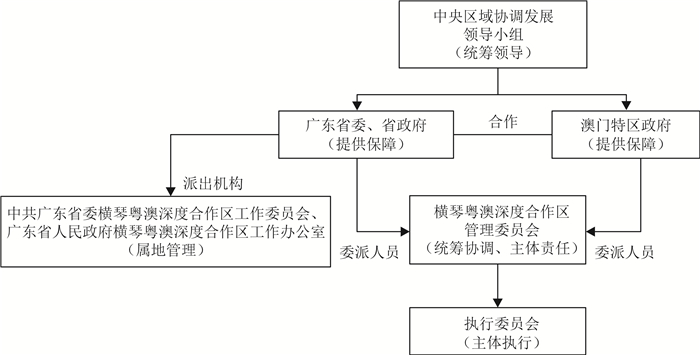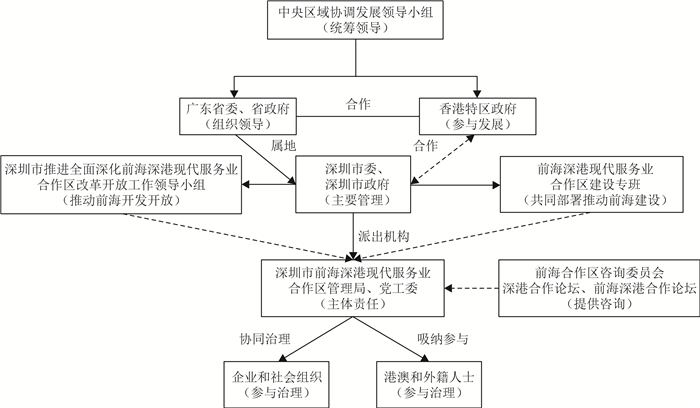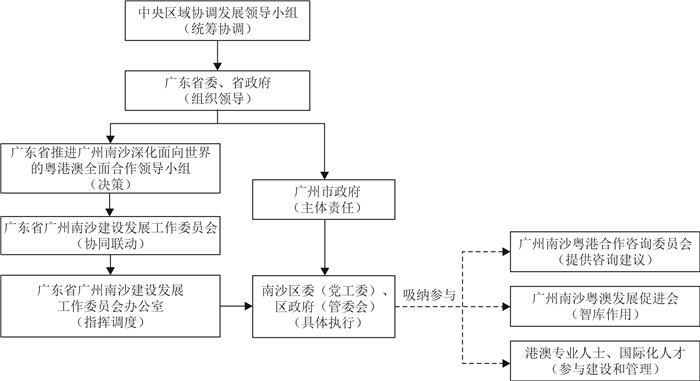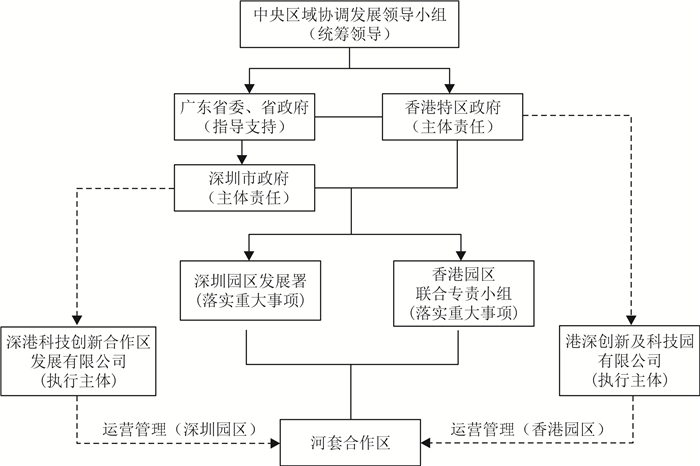A Comparative Study on the Regional Governance Models of Four Major Cooperation Platforms in Guangdong-Hong Kong-Macao Greater Bay Area
-
摘要:
推进重大合作平台建设是粤港澳大湾区落实“一点两地”新定位,进一步全面深化改革、稳步扩大制度型开放的重要依托,有利于“以点带面”引领带动粤港澳全面深化合作。从实践来看,四个重大合作平台在建设发展过程中逐步形成了图景各异的区域治理模式:横琴的“合作政府”治理模式、前海的“法定机构”治理模式、南沙的“属地管理”治理模式以及河套的“园区合作”治理模式。比较四大合作平台区域治理模式的样态可以发现,纵向、横向、斜向和网络状的府际关系对于形塑多样化的区域治理权力结构产生了不同的作用。“自上而下”是四大合作平台构建区域治理权力结构的共同路径;府际权力配置是四大合作平台构建区域治理权力结构的差异化条件。区位属性、服务对象、战略定位、利益配置催生了不同的区域治理模式。
Abstract:Promoting the construction of major cooperation platforms serves as a crucial window for the Guangdong-Hong Kong-Macao Greater Bay Area to fulfill its new positioning of "one point, two places" and further comprehensively deepen reforms and steadily expand institutional openness, thereby facilitating the "point-to-area" approach to lead and drive the comprehensive deepening of cooperation among Guangdong, Hong Kong, and Macao. From a practical perspective, the four major cooperation platforms have gradually evolved into distinct regional governance models during their construction and development: the "cooperative government" model in Hengqin, the "statutory organization" model in Qianhai, the "localization management" model in Nansha, and the "park cooperation" model in Hetao. A comparison of the regional governance models of the four cooperation platforms reveals that vertical, horizontal, diagonal and networked intergovernmental relations have played different roles in shaping the diverse power structures of regional governance. The "top-down" approach is the common path for the four platforms to build regional governance power structure, while the intergovernmental power configuration is the differentiated condition for the four platforms to build regional governance power structure. Location attribute, service object, strategic positioning, and interest allocation are the four influencing factors that give rise to different regional governance models.
-
引言
建设粤港澳大湾区是习近平总书记亲自谋划、亲自部署、亲自推动的重大国家战略。由于港澳地区存在“一国两制”的制度独特性,粤港澳大湾区城市群建设呈现出了世界其他湾区所不具有的特殊性和复杂性,是一项长期而艰巨的系统工程,需要锚定“一点两地”的全新定位,分阶段、分步骤、分领域有序推进。自2019年2月18日《粤港澳大湾区发展规划纲要》颁布实施以来,中央政府接连出台支持粤港澳大湾区重大合作平台的建设方案或规划,打造粤港澳大湾区建设的桥头堡,建立起横琴、前海、南沙、河套四个重大合作平台体系框架,以期“以点带面”引领带动粤港澳全面深化合作,支持香港、澳门更好融入国家发展大局,保持长期繁荣稳定。
作为粤港澳大湾区制度型开放的重要窗口,四大合作平台在区域开放布局中承载着不同的功能分工,呈现出特色多样的区域开放样态。相应地,四大合作平台在建设发展过程中逐渐形成了风格迥异的区域治理模式。有学者提出,横琴粤澳深度合作区(下文简称横琴粤澳深合区)的共管体制蕴含着“多层政府、共同治理”的制度特性,是“一国两制”体制下府际合作的新模式[1-2];前海深港现代服务业合作区(下文简称前海合作区)的“法定机构”治理模式经历了从“深港合作开发管理”到“深港府际管理”的发展演变[3];南沙合作区在协同港澳的发展道路上不断创新粤港澳合作模式,其区域治理模式实质上是当地政府负主体责任的“属地管理”模式;而在“一区两园”格局和深港共建的开发模式下,河套深港科技创新合作区(下文简称河套合作区)实行“园区合作”的管理体制[4]。
四个重大合作平台都是地处经济文化环境类同的粤港澳大湾区,为什么有的平台形成了以合作双方政府为核心主体的治理模式,有的平台衍生出“以法定机构承载部分政府区域治理职能”的治理新模式,有的平台一直保持当地政府进行属地管理的治理模式,而有的平台则形成了基于专责小组的“园区合作”治理模式?更进一步看,各合作平台区域治理模式的具体样态是怎样的?它们之间有着怎样的共性和差异?本文拟采用比较研究方法,基于府际关系的理论视角对粤港澳大湾区四个重大合作平台的区域治理模式进行理论阐释,以回答上述问题。
一. 文献回顾与分析框架
一 粤港澳大湾区重大合作平台的相关研究
随着粤港澳大湾区建设的纵深发展,学界对粤港澳大湾区重大合作平台的研究也日益活跃起来。目前,研究者主要聚焦四个方面。一是对单个重大合作平台的专门研究。有学者关注粤澳合作开发横琴过程中取得的政策效果、基本动因以及珠澳合作开发横琴过程中的多重政府间关系[5-6],提出“政府主导、多元协同”是横琴跨境治理的未来方向[7]。进入横琴粤澳深合区阶段后,有学者强调制度创新在实现横琴与澳门一体化发展中的关键作用[2],通过比较分析与三个国际典型跨境合作区的共性和差异[8],探讨了横琴粤澳深合区的共管体制,揭示出“多层政府、共同治理”的制度特性[1]。关于前海合作区,有学者关注其制度设计和制度创新,探究前海如何借鉴“法定机构”管理模式[9],基于治理主体、治理方式、治理目标的逻辑架构提出了前海区域协同治理模式[10];也有学者总结前海合作区的跨境治理模式创新,经历了从“深港合作开发管理”到“深港府际管理”的阶段演变[3];还有学者基于新国家空间理论,考察了港深协同发展中的跨界治理特征[11],从价值理性和工具理性的角度分析了前海实践的开放价值和创新发展[12]。有学者聚焦粤港澳大湾区跨界合作区的规划策略与协同治理,分析南沙作为粤港澳大湾区重要跨界合作平台的规划与发展[13]。针对河套合作区的研究则主要围绕其发展历史展开。有学者分析了河套的发展历程,认为河套地区发展缓慢的原因包括土地权属不清、城市发展规划受限、基础设施落后、深港政府合作意愿低等[14]。二是涉及两个重大合作平台的比较研究。有学者以前海合作区与横琴粤澳深合区为案例解析区域跨界一体化进程,指出前海与横琴的规划发展分别体现了区域长期积累与国家力量介入的双重效应[15]。另有学者对前海和横琴的跨境治理模式进行比较,认为横琴粤澳深合区所构建的跨境治理体制具有显著的府际关系重塑意味,而前海合作区的区域治理模式则是府际管理实践样态的创新体现[3]。三是针对三个重大合作平台的比较研究。有学者认为前海、横琴、南沙在治理主体、手段和机制上各有侧重,形成了具有法定机构特色的“前海模式”、政府政策工具主导的“横琴模式”和强调社会复合主体参与的“南沙模式”[16]。四是关注四个重大合作平台的协同发展问题。针对粤港澳三地科技创新协同发展的短板,有学者提出基于“多平台叠加”的“自贸区+重大平台+特色平台”纵向协同发展模式,以及基于“雁阵联动”的“4+N”横向协同发展模式,推动横琴、前海、南沙、河套四个重大合作平台的科技创新协同发展[17]。
综上所述,一是现有研究主要针对单个重大合作平台的实践案例进行论述,且横琴和前海受到了更多的关注,而涉及南沙和河套的研究相对较少。二是对重大合作平台治理模式的比较研究主要涉及两个或三个重大合作平台,鲜有对四个重大合作平台进行整体性比较。虽有个别文献涉及四个重大合作平台的科技创新协同发展问题,但尚未从区域治理模式的视角进行比较研究。三是已有研究虽从不同视角分析了重大合作平台的体制机制创新,包括跨境治理、跨界治理、协同治理等,但未能从区域治理的学理视角进行更深入的探究。为此,本文将构建统一的分析框架,率先对大湾区四个重大合作平台的区域治理模式做进一步的比较研究。
二 大湾区四大合作平台区域治理模式的比较分析框架
一般认为,公共治理的主体包括公共机构、私人机构和非营利组织,或者指政府、市场与社会组织。国家治理、地方治理和基层治理如此,区域治理也不例外。但无论在何种治理层级或场域中,政府都是“治理的最重要的主体”[18]。在中国,随着区域开放和区域协调发展战略的深入实施,区域治理愈发成为国家治理体系的重要组成部分。在党中央集中统一领导下,中国的区域开放和区域协调发展战略通过自上而下的顶层设计和高位推动来实现。不同于西方语境下“去政府化”或“弱行政化”的区域治理样态和区域治理模式,在中国的区域治理实践中,党委和政府扮演着核心行动者的角色。因此,要深入理解中国区域治理的内在逻辑和深层密码,就必须充分认识到党委和政府的作用。正是在这一意义上,政府间关系即府际关系对区域治理的影响尤为关键[19]。
林尚立认为,政府间关系主要包含纵向的中央政府与地方政府间关系、地方各级政府间关系,以及平行横向和斜交横向的各地区政府间关系。纵向政府间关系指的是在单一制的国家结构下,中央政府与地方政府之间以及地方上下级政府之间的关系;横向政府间关系指的是相同级别政府之间的关系,包括同一行政区域内各同级政府之间以及不同行政区域内同级政府之间的关系;斜向政府间关系是指行政级别不同且没有直接隶属关系的地方政府之间的关系[20]。在此基础上,有学者提出了网络型府际关系的观点,认为政府间关系逐渐呈现出多元主体平等参与的网络型特征,在形式上与横向、纵向、斜向模式相互补充、相互利用[21]。所谓网络型府际关系,指的是中央政府与各级地方政府间纵、横、斜错综交织的网络状府际关系,并将非政府的多元主体纳入网络结构体系内[22]。在粤港澳大湾区四个重大合作平台的区域治理情境中,政府间关系也具体表现为四个向度:纵向上,中央政府与粤港澳政府形成的央地关系,以及广东省政府与地市政府之间的上下级隶属关系;横向上,广东省与香港特别行政区、澳门特别行政区的省级政府间关系;斜向上,香港、澳门特别行政区政府与深圳、珠海、广州等地市政府的政府间关系;网状,即以上三种府际关系复合交织而成的网状府际关系。在纵向、横向、斜向及网状等多重向度的府际关系驱动下,纵向层级政府或横向地方政府通过权力配置以及不同权力之间的相互作用,形塑出差异化的区域治理权力结构[23],进而衍生出样态多元的区域治理模式。由此可见,不同的府际关系塑造出的区域治理权力结构,是辨析四个重大合作平台区域治理模式的核心要素。
根据上述理论逻辑,本文构建出大湾区四个重大合作平台区域治理模式的比较分析框架(见图 1),并将其分类归纳为横琴的“合作政府”治理模式、前海的“法定机构”治理模式、南沙的“属地管理”治理模式以及河套的“园区合作”治理模式。
二. 四大合作平台区域治理模式的现实样态
“一国两制”背景下的粤港澳大湾区建设涉及中央政府、粤港澳三方政府以及各地市政府三个层级的行动者,是一种多层级治理的制度性创新[24]。香港、澳门回归祖国后,广东省政府、香港特区政府、澳门特区政府以及深圳、珠海、广州市政府在四个重大合作平台的开发建设中,日益担当起不同的角色。尤其在粤港澳大湾区建设重大国家战略的推动下,中央政府扮演了顶层设计者和高位推动者的角色,大湾区各级政府根据各自的权力范围和职责分工展开集体行动,形成了“分类对接” “跨层协调”的中国特色区域治理新模式[25]。在一种新型的包容性府际关系范导下[26],四个重大合作平台逐步生成了迥异的区域治理模式。
一 横琴粤澳深合区:横向府际关系主导下的“合作政府”治理模式
近年来,中央与广东、澳门、珠海围绕横琴粤澳深合区的跨境治理事务形成了纵向领导协调、横向主导落实以及斜向配合支持的府际关系,建构了极具特色的“合作政府”治理模式(见图 2)。在纵向上,中央区域协调发展领导小组代表中央政府统筹领导横琴粤澳深合区的发展建设,协调推动粤澳双方的合作关系。广东省委、省政府通过设立中共广东省委横琴粤澳深度合作区工作委员会、广东省人民政府横琴粤澳深度合作区工作办公室等派出机构履行属地管理职能,实现地方利益与国家战略的协调统一。珠海市作为广东省政府的下辖政府,与省政府保持紧密的上下级关系,配合和支持横琴粤澳深合区的各项建设工作。在横向上,根据《横琴粤澳深度合作区建设总体方案》(以下简称《横琴方案》)以及《横琴粤澳深度合作区总体发展规划》(以下简称《横琴规划》)的相关规定,在“共商共建共管共享”(以下简称“四共”)的治理体制下,横琴粤澳深合区由广东省政府和澳门特区政府以“双主任制”、管理委员会和执行委员会的架构实现合作共治。“四共”体制使澳方能够深度参与横琴粤澳深合区建设中的经济、行政、民生等事务,并与粤方共同承担横琴开发建设的主体责任。在斜向上,横琴粤澳深合区成立之前,珠海市政府虽仅是地级市政府,却是横琴岛的属地开发和管理者;而澳门特区政府虽在行政级别上高于珠海市政府,却无法共享横琴开发建设的实际管理权限,因而一度形成了微妙的“非对称府际关系”[27]。随着横琴粤澳深合区开发建设上升为国家战略,在中央统筹领导下由粤澳双方来主导,珠澳政府之间的合作关系发生了重要变化,珠海市政府由以前的“主导者”角色转变为如今的“支持者”角色。由此可见,在纵向、横向和斜向的三重府际关系中,由粤澳双方政府重塑“四共”横向府际关系进而驱动建构的“合作政府”,是横琴粤澳深合区跨境治理的核心行动者。为此,本文把横琴粤澳深合区的区域治理模式概称为以横向府际关系为主导的“合作政府”治理模式。
二 前海合作区:网络型府际关系主导下的“法定机构”治理模式
早在深圳经济特区建立30周年的2010年,国务院就批复同意《前海深港现代服务业合作区总体发展规划》,明确要把前海建设成粤港现代服务业创新合作示范区。在管理架构上,前海合作区借鉴香港经验成立了法定机构——前海管理局,担负起合作区管理的主体责任。2021年9月,中共中央、国务院印发《全面深化前海深港现代服务业合作区改革开放方案》(以下简称《前海方案》)。2023年12月,国务院正式批复实施《前海深港现代服务业合作区总体发展规划》)(以下简称《前海规划》)。在《前海方案》和《前海规划》的制度安排下,前海合作区的治理架构进一步完善:构建起党政机构、前海管理局以及其他多元主体协同参与的格局,形成了纵、横、斜向府际关系错综交织、多元主体共治的网络型府际关系(见图 3)。从纵向看,中央区域协调发展领导小组在前海合作区治理过程中发挥着统筹领导的作用,借助强大的政治势能,高位推动前海合作区建设;广东省委、广东省政府则发挥组织领导和沟通协调作用,为前海合作区发展中的关键性、全局性问题提供战略指导和协调服务;深圳市作为前海合作区的直接管理者,在市委、市政府层面成立了合作区改革开放工作领导小组,发挥地方政府的主导作用。从横向看,广东省政府和香港特区政府的高级官员建立了粤港合作框架和粤港合作联席会议机制,目的是促进粤港在贸易、经济、跨境基础设施等方面的合作协调。从斜向看,深圳市政府与香港特区政府联合组建建设专班,共同部署推动前海合作区建设;同时,香港特区政府通过深港各层级合作机制,加大力度参与前海合作区的发展建设。在社会参与上,一方面,前海咨询委员会等咨询机构有效发挥了智囊团的作用,为前海合作区的建设发展提供咨询意见;另一方面,《前海方案》与《前海规划》均提出,要拓宽港澳和外籍人士参与前海治理渠道,包括“符合条件的港澳和外籍人士到前海法定机构担任职务”,“完善前海咨询委员会运行机制”等。可见,在横纵交错、斜向穿插、多主体参与的网状府际关系作用下,前海合作区探索形成了网络型府际关系主导下的“法定机构”治理模式,由深圳市政府的派出机构即前海管理局履行主体责任,承载部分政府区域治理的职能,实行市场化运行、企业化管理的运行机制。
![]() 图 3 前海合作区的“法定机构”治理模式资料来源:结合《前海方案》《前海规划》、深圳市前海管理局官方网站的相关资料以及相关文献[3]自制。
图 3 前海合作区的“法定机构”治理模式资料来源:结合《前海方案》《前海规划》、深圳市前海管理局官方网站的相关资料以及相关文献[3]自制。三 南沙合作区:纵向府际关系主导下的“属地管理”治理模式
自1993年国务院批准设立广州南沙经济开发区开始,到2022年国务院印发《广州南沙深化面向世界的粤港澳全面合作总体方案》(以下简称《南沙方案》),南沙合作区的开发建设迄今走过了30多个年头。从国家级新区、自贸试验区、粤港澳全面合作示范区,到打造成为立足湾区、协同港澳、面向世界的重大战略性平台,南沙合作区的战略地位不断攀升。但无论南沙合作区的定位如何调整,其主要由广州市尤其是南沙区委、区政府自行进行“属地管理”的模式一直未有大的变化。当前,在《南沙方案》的加持推动下,南沙合作区更好地理顺了省、市、区三级纵向政府的关系,进一步完善了由南沙区委、区政府负主体责任的“属地管理”模式(见图 4)。一方面,作为四个重大合作平台之一,南沙合作区的建设发展要接受中央政府的统筹领导,并得到中央相关部委的政策指导和支持;另一方面,广东省政府、广州市政府与南沙区政府需确保国家战略的落地实施,实现国家发展目标与地方发展需求的有机结合。为此,自《南沙方案》出台后,南沙合作区构建起广东省、广州市、南沙区三级联动的决策、协调、执行机制,广东省成立由广东省委、广州市委主要领导任组长、副组长的领导小组,通过设立广东省南沙建设发展工作委员会与广东省南沙建设发展工作委员会办公室等机构,加强对南沙发展的宏观指导和沟通协调;广州市政府负责南沙合作区开发建设的资源调配和监督考核;南沙区委(党工委)、区政府(管委会)则负责属地的执行落实工作。此外,南沙区政府与港澳特区政府虽未建立直接的斜向府际合作机制,但通过搭建与港澳合作的“双桥梁”——广州南沙粤港合作咨询委员会与广州南沙粤澳发展促进会,吸纳港澳政府人员、专业人士和国际化人才参与南沙合作区建设。可见,在纵向府际关系的驱动下,南沙合作区通过构建三级联动的决策、协调、执行机制,确保政令畅通,明确了地方政府在区域治理中的核心地位,形成了以南沙本地党委和政府为权力主体的“属地管理”模式。
四 河套合作区:斜向府际关系主导下的“园区合作”治理模式
从2008年港深双方政府签订《关于港深推进落马洲河套地区共同发展的合作备忘录》,到2023年国务院出台《河套深港科技创新合作区深圳园区发展规划》(以下简称《河套规划》),河套合作区的管理体制机制不断深化。在纵向、横向和斜向三重向度的府际关系驱动下,河套合作区形成了独特的权力结构和治理模式(见图 5)。从纵向看,中央区域协调发展领导小组通过政策引导和资源支持,为合作区的发展提供宏观指导,《河套规划》的出台正是中央政府层面推动深港科技创新合作的重要举措;广东省政府对深圳市政府推进河套合作区建设提供具体的政策指导和业务支持;深圳市政府是直接负责园区发展的地方政府,承担着落实国家战略意图的主体责任。从横向看,河套合作区主要涉及深港合作,广东省政府更多是基于粤港合作框架和粤港合作联席会议机制扮演“协调者”的角色,因此,深圳市政府与香港特区政府的斜向府际合作对于河套合作区的具体建设至关重要。《河套规划》明确提出:“深化深港双方合作区建设发展协调机制”,“支持深港双方联合成立深圳园区理事会和专家咨询委员会”,“形成协同规划、联合建设、共享成果的合作推进机制”。河套合作区实行的是“一区两园”下的“园区合作”管理机制,由深圳市政府与香港特区政府履行主体责任,双方依托共同组建的香港园区联合专责小组以及深圳园区发展署共同推进河套合作区建设,且两个园区都按照香港市场化的管理模式分别由各自的机构进行经营与管理,实现了在规划、建设、管理等方面的深度合作。由此可见,深港政府构成的斜向府际关系突破了传统的行政层级限制,使得深港双方能够在更灵活、更高效的框架下推进河套合作区的建设,为河套合作区形成“园区合作”治理模式提供了最主要的推动力。
三. 四大合作平台区域治理权力结构的显著特质
区域治理的权力结构差异是比较分析区域治理模式的核心,而区域治理权力结构的差异又是由不同的府际关系所塑造和衍生出来的。比较四大合作平台区域治理模式的样态可以发现,纵向、横向、斜向和网络状的府际关系对形塑多样化的区域治理权力结构产生了不同的作用。下文从两方面进一步比较分析四大合作平台的区域治理权力结构,以更好地揭示复杂府际关系网络嵌套下粤港澳大湾区四大合作平台区域治理模式的异同。
一 “自上而下”是四大合作平台构建区域治理权力结构的共同路径
在中国的区域治理实践中,“自上而下”模式指的是由中央政府直接参与或推动成立专门的区域治理组织,地方政府在治理组织框架下开展合作并达成集体行动[28]。虽然四大合作平台的区域治理体制机制有所不同,但它们都有一个显著共性,即基于“一国两制”这一特殊的纵向府际关系[29],中央政府通过“自上而下”的纵向政府间权力配置构建了多层次的区域治理组织框架。在中国这样一个具有深厚中央集权传统的单一制国家中,纵向政府间的权力配置对区域治理起着决定性作用。纵向维度的权力配置不仅塑造了区域治理的基本格局,而且深刻影响着横向维度权力配置的实现程度和演进轨迹[30]。从权力结构的角度来看,广东省与港澳特别行政区虽然是三个地位平等的地方行政区域,但由于港澳享有高度的自治权,权力范围大于作为单一制下地方行政区域的广东省传统的权力范围[31],二者所产生的“非对称关系”在一定程度上制约了粤港(澳)之间的区域合作,需要中央政府统筹协调粤港澳三方政府间关系。因此,中央层面成立了中央区域协调发展领导小组,统筹领导或协调四大合作平台的建设工作,并陆续出台推进重大合作平台建设的政策方案或规划文件,推动粤港澳省级政府和深圳、珠海、广州等地市政府扮演好不同层级的治理角色。相应地,地方层面则通过构建各种形式的区域治理组织如领导小组、派出机构、管理委员会和执行委员会等,推动落实国家战略和政策规划。概言之,区域治理权力结构“自上而下”的塑造路径,是粤港澳大湾区四大合作平台区域治理模式最本质的特点和最重要的机制。
二 府际权力配置是四大合作平台构建区域治理权力结构的差异化条件
府际权力的配置涉及不同层级政府的自主性和可获取的施政资源,府际权力的运行方式直接影响不同层级政府的行为[32]。在“一国两制”的独特制度环境下,粤港澳大湾区四大合作平台的府际权力配置存在差异化,由此形成了形态各异的区域治理权力结构。在横琴粤澳深合区,粤澳通过“四共”体制实现了双方政府在权力分配上的深度融合与平衡。尤其是,横琴粤澳深合区管理委员会与执行委员会的组建进一步细化了权力分配,确保粤澳双方能够共同参与决策、执行和监督等各个环节。在前海合作区,广东省政府与深圳市政府在保持政策协调权和重大事务决策权的基础上,通过权力下放赋予前海合作区更多的自主权和灵活性,给予前海管理局相对独立的决策权、执行权和运营权。南沙合作区作为一个典型的属地管理区域,区域治理模式受到广东省、广州市和南沙区政府之间权力调配的影响。在“地—地”(地方与地方)纵向府际关系的主导下,通过层级控制和各级联动的权力配置,确保不同层级政府间的自主性与协作性达到一定平衡,这样既保证了省级政府对南沙合作区发展的总体把控,又赋予了南沙区委、区政府足够的自主权。而作为连接深港两地的重要节点,河套合作区的治理需要妥善处理好深港两地政府间的“非对称关系”。这种斜向府际关系要求深港双方在权力配置上更加注重“瘦身”与高效,以更少的权力保障合作双方的更大权益,尽量按香港的规则来量身打造园区合作机制。
四. 四大合作平台区域治理模式迥异的影响因素
四大合作平台同处粤港澳大湾区,为何却形成了样态迥异的区域治理模式?采用内容分析法,对比四大合作平台的纲领性政策文件发现,中央政府对重大合作平台的“区位属性”“服务对象”“战略定位”等方面都进行了顶层设计和重点部署。这是影响四个重大合作平台建设及其治理模式差异的基础条件。此外,从本质看,府际关系的维持与运作以权力配置和利益配置为主导[33]。区域治理中的“利益配置”是不同权力主体之间竞争与合作的“黏合剂”,关系到各权力主体积极性和合作的持续性,是维护区域治理秩序的重要因素。下文围绕区位属性、服务对象、战略定位、利益配置四个方面,进一步阐释大湾区四大合作平台区域治理模式迥异的影响因素。
一 区位属性影响四大平台区域治理模式的构建基础
大湾区四大合作平台均处于珠江口及周边地区,是连接内地与港澳的重要枢纽。它们虽同处粤港澳大湾区,但事实上又具有不同的区位属性,这是塑造形态各异的区域治理模式的天然条件。具体看,横琴和河套都属于“一国两制”新示范、新实践的跨境区域,在合作区内均存在制度、法律、关税区及文化等方面的差异,涉及跨境政府合作、跨境政策协调以及跨境社会治理等方面的治理复杂性,因而形成独特的跨境区域治理模式。具体而言,横琴位于“一国两制”的交汇点和“内外辐射”的接合部,由关境内政府和关境外政府共同管理,形成了“一国两制”制度框架下“国内境外”的跨境区域治理模式;而面积最小的河套合作区,因“一河两岸”的天然格局,由深圳与香港“跨境共建”,位于深港跨境治理交汇处,在物理空间上实质性地进行了“跨境合作”,从而形成了“一区两园”下的“园区合作”管理体制。与之不同的是,前海合作区和南沙合作区都是带有港澳元素的内地区域,涉及港澳居民在这两个区域学习、工作和生活等方面的社会权利和经济权利,主要面临经济合作、社会治理、社会政策等方面的跨制度治理难题。因此,前海合作区基于“法定机构”的体制机制,结合市场力量,在完善社会治理格局、构建多元化纠纷解决体系等方面推进社会治理模式创新,同时拓宽港澳和外籍人士参与前海治理的渠道。南沙合作区以港澳合作项目为运作方式,通过社会化、市场化的运作模式,强调社会复合治理主体的参与,形成了“协同港澳”的跨界协同治理机制[16]。由此可见,区位属性不仅是地理上的特殊性,更包含了由地理位置所衍生的经济、社会、制度等方面的互动关系,进而塑造了各合作平台在大湾区建设中的独特角色。
二 服务对象影响四大平台区域治理模式的政策导向
从宏观上讲,四大合作平台均具有“引领带动粤港澳全面合作、丰富‘一国两制’实践内涵”的重要价值与功能。但具体来看,四大合作平台的服务对象各有侧重,而服务对象的不同需求也在一定程度上影响到四大合作平台的政策导向和内部治理结构。比如,横琴粤澳深合区建设主要服务于澳门,其初心是为澳门经济适度多元发展创造条件。针对“促进澳门经济适度多元发展”的服务需求,粤澳双方通过制度创新,在政府行政、经济运行、社会治理等领域探索制度融合,形成了以“合作政府”为特征的治理模式。又如,前海合作区的功能主要是支持香港经济社会发展,为此,在借鉴香港治理经验的基础上,构建了以前海管理局这一法定机构为核心的治理组织,以更好地服务香港,推动香港金融和专业服务与内地对接与发展。再如,作为粤港澳大湾区的几何中心和未来之城,南沙合作区的定位是“立足湾区、协同港澳、面向世界”,其服务对象并不侧重香港或澳门,而是着眼整个大湾区。为此,南沙合作区通过搭建广州南沙粤港合作咨询委员会和广州南沙粤澳发展促进会的“双桥梁”、布局协同港澳的产业项目,携手港澳共同扩大对外开放,进一步促进粤港澳三方全方位、多层次的合作。而河套合作区主要服务于深圳和香港的科技创新领域,其独特的“园区合作”模式旨在满足来自香港和内地的企业、科研机构和高端人才对新质生产力发展的迫切需求,促进深港两地在科创领域尽快提质增效。同时,引入香港市场化的运营机制,能够促进创新要素的自由流动和优化配置,推动合作区在科技创新、产业升级等方面快速发展。
三 战略定位影响四大平台区域治理模式的顶层设计
四大合作平台在粤港澳大湾区建设中具有错位发展的目标和战略定位,因此国家在规划位阶、建设重点、政策举措方面作了差别化设计。例如,同为国家级规划方案,《横琴方案》《前海方案》由中共中央、国务院联合印发,而《南沙方案》《河套规划》由国务院印发。这表明,前二者的位阶更高、地位更凸显,因而需要中央政府投放更多的注意力,合作区治理体制机制创新的必要性更强。横琴粤澳深合区的四大战略定位之一是丰富“一国两制”实践的新示范,因此需要探索与“一国两制”相适应的新体制新机制,颠覆性创新构建“合作政府”治理模式,突破旧有行政区域划分造成的制度藩篱,形成生活和营商环境逐步趋同的“粤澳深度合作区”[34]。前海合作区作为深港深度融合发展的引领区,战略定位包括“打造全面深化改革创新试验平台”和“建设高水平对外开放的门户枢纽”,是中国稳步推进制度型开放的压力测试区。因此,其治理模式创新更注重与香港接轨、衔接,着力构建一个精干高效的区域治理共同体;而由法定机构承载部分政府区域治理职能的体制机制,迎合了战略定位需求。南沙合作区的战略定位是促进粤港澳三地的全面合作,注重与港澳的协同合作和对外开放。因此,南沙合作区在坚持“属地管理”主体架构的同时,积极探索与港澳的规则衔接与机制对接,采取了类似香港的咨委会运作模式和具有澳门特色的民间非营利社会团体运作模式。河套合作区的战略定位是“深港科技创新开放合作先导区”“国际先进科技创新规则试验区”“粤港澳大湾区中试转化集聚区”,是有效支撑粤港澳大湾区国际科技创新中心建设的重要支点。为有效践行这些战略定位,深港双方摆脱了斜向府际关系的制度束缚,创新性地引入“一区两园”管理体制,采用公司化运营机制,最大化地赋能科技创新。
四 利益配置影响四大平台区域治理模式的运行机制
在“粤港澳大湾区建设”这一重大国家战略的嵌入下,各地方政府间形成了竞争型府际合作[35],拥有“理性人”和“代理人”双重身份的地方政府基于不同的利益诉求,在区域合作治理过程中进行一定程度的利益博弈。各大合作平台不仅要响应国家战略、促进区域经济一体化和高质量发展,还要协调中央与地方、地方与地方之间以及内地地方政府与港澳特区政府的利益关系,通过合理的利益配置激励各层级政府参与区域治理。具体而言,横琴开发牵涉了中央政府、广东省政府、澳门特别行政区政府、珠海市政府等利益相关方。在横琴新区阶段,珠(粤)澳双方曾有过利益分歧和竞争关系,无法形成强大合力共同推动横琴开发建设。因此,在横琴粤澳深合区“四共”体制下,中央通过一系列让权、放权、赋权机制重塑粤(珠)澳之间的府际关系以及建立合作区收益共享机制,更好地处理多方政府在横琴开发建设中的利益分歧,实现横琴开发的初心。前海合作区的服务对象是香港,但香港特区政府并未直接参与合作区的事务管理。从府际管理层面看,前海合作区的利益配置更多聚焦前海管理局与深圳市政府之间的关系调适,以及管理局作为法定机构在市场化运作中的相对独立性。除此之外,将深圳市宝安区、南山区部分区域划入合作区后,前海合作区还需处理好与南山、宝安两个行政区的职责分工问题。南沙合作区始终隶属广州市尤其是南沙区政府管辖,不涉及与中央、广东省尤其是港澳特区政府的利益分配和利益博弈问题。因此,沿袭纵向府际关系主导下的“属地管理”模式,对南沙合作区是较为合适的选择。在此模式下,港澳双方人员虽然能够通过广州南沙粤港合作咨询委员会、广州南沙粤澳发展促进会等平台参与南沙建设和管理,但港澳特区政府在南沙开发建设中均无相应的管理权限。在深港双方“一园两区”运作模式中,河套合作区面临着深港两地政府间、企业间的分工合作问题,其利益配置主要是解决跨境治理中的法制、体制、规则和机制差异。而且,河套合作区起步较晚,历史包袱不多,目标定位也更为单纯,因而深港双方在园区建设上的利益博弈较小,适合采用“最小的政府就是最好的治理”模式。
结语
2023年4月,习近平总书记在视察广东时赋予粤港澳大湾区“一点两地”新的战略定位和历史使命,对推进重大合作平台建设发展提出了新的政治要求。本文采用横向比较研究法,基于纵向、横向、斜向及网状等复合向度府际关系的理论视角,对粤港澳大湾区四个重大合作平台区域治理模式的不同样态、区域治理权力结构的显著特质、衍生不同模式的影响因素进行了分析,揭示出四大合作平台区域治理模式的共性和差异,探究了四大合作平台区域治理实践“殊途”又“同归”的深层逻辑。
本文的主要贡献在于拓展了中国区域治理理论的研究边界,丰富了“一国两制”理论在区域治理场域的应用场景,为研究复杂制度背景下的区域治理模式提供了新的分析框架和思路。传统区域治理理论多聚焦于单一制度或类同制度背景下的治理模式研究,本文通过剖析粤港澳大湾区四大合作平台的区域治理实践,阐释了它们如何在“一国两制”实践中形塑出特色各异的区域治理模式,提供了对“一国两制”下区域治理模式多样性的理论解释,为区域治理的理论研究注入了新的活力,有助于讲好具有中国特色、“一国两制”实践内涵的粤港澳大湾区区域治理故事。
也需指出,本文只是从横向比较的角度分析了四大合作平台的区域治理模式,但四大合作平台有着不同的历史发展脉络,横向的比较分析难以充分呈现各个合作平台在不同历史阶段所面临的特定环境的复杂性和多样性。因此,有待进行纵向视角下的比较历史分析,通过深入挖掘重大合作平台的历史发展轨迹,分析其治理模式随时间、政策导向以及区域需求变化的演进过程,揭示其区域治理模式变化的内在逻辑和规律,并从中提炼出对当前和未来区域治理有启迪意义的经验或教训。此外,随着深中通道的正式通车,粤港澳大湾区内部的硬联通得到了更显著提升,四大合作平台之间的时空距离进一步缩短。这不仅加速了区域间的要素流动,也为构建高效协同治理网络提供了契机。四大合作平台如何发挥各自的独特优势、创新区域合作治理体制机制,形成更有利于粤港澳大湾区整体发展的区域协同治理网络,值得进一步跟踪研究。
-
图 3 前海合作区的“法定机构”治理模式
资料来源:结合《前海方案》《前海规划》、深圳市前海管理局官方网站的相关资料以及相关文献[3]自制。
-
[1] 鄞益奋, 曾栋. 横琴粤澳深度合作区的共管体制[J]. 华南师范大学学报(社会科学版), 2023(2): 17-25. http://journal-s.scnu.edu.cn/cn/article/id/d3c8d053-72d7-487f-8abe-ed6124415b03 [2] 李可, 唐晓晴. 横琴粤澳深度合作区: 理念创新与制度构建[J]. 港澳研究, 2022(1): 13-24. [3] 杨爱平, 周品仪. 府际管理视角下前海合作区的跨境治理模式创新[J]. 复旦城市治理评论, 2022(2): 57-80. [4] 张克科. 深港科技创新口述史: 河套的前世今生与深港合作[M]. 北京: 新华出版社, 2023: 267-272. [5] 谢宝剑, 陈广汉. 粤澳合作开发横琴的现状与前瞻——基于博弈论的视角[J]. 亚太经济, 2012(1): 143-148. [6] 鄞益奋. 珠澳合作开发横琴中的政府间关系[J]. 澳门理工学报(人文社会科学版), 2020(4): 44-54. [7] 殷旭东. 大湾区背景下横琴跨境治理与"一国两制"新实践[J]. 武汉公安干部学院学报, 2021, 35(4): 1-5. [8] 陈朋亲, 毛艳华. 横琴粤澳深度合作区与国外典型跨境合作区治理比较研究[J]. 华南师范大学学报(社会科学版), 2023(2): 26-38. http://journal-s.scnu.edu.cn/article/id/799104ed-49f4-42e4-a178-f3c8b976e931 [9] 崔健, 杨珊. 前海合作区法定机构运作模式探究[J]. 特区实践与理论, 2011(5): 84-87. [10] 谢宝剑. 深圳前海区域治理模式创新研究[J]. 澳门理工学报(人文社会科学版), 2022(2): 40-51. [11] 周子航, 施德浩, 王雨. 港深协同发展: 香港北部都会区与前海合作区的跨界治理——基于新国家空间理论的考察[J]. 城市发展研究, 2022, 29(10): 1-11. [12] 张玉阁. 前海实践的价值理性和工具理性[J]. 澳门理工学报(人文社会科学版), 2022(4): 26-38. [13] 王世福, 练东鑫, 邓昭华, 等. 粤港澳大湾区跨界合作区规划策略与协同治理探索——以广州南沙新区为例[J]. 规划师, 2023, 39(3): 101-108. [14] 朱东山. 香港落马洲河套地区发展再思考[J]. 特区经济, 2019(3): 34-36. [15] 陈宏胜, 李志刚, 肖扬, 等. 基于区域功能视角的边界新区发展研究——对深圳前海合作区与珠海横琴合作区的比较[J]. 城市规划, 2022, 46(4): 21-29. [16] 陈朋亲, 毛艳华. 粤港澳大湾区跨域协同治理创新模式研究——基于前海、横琴、南沙三个重大合作平台的比较[J]. 中山大学学报(社会科学版), 2023, 63(5): 167-176. [17] 谢宝剑. 粤港澳大湾区重大合作平台协同发展研究[J]. 澳门理工学报(人文社会科学版), 2024(2): 36-47. [18] 唐娟. 政府治理论[M]. 北京: 中国社会科学出版社, 2006: 32. [19] 刘兴成. 区域合作治理: 重塑府际关系的新趋向——基于近年来国内相关文献的研究述评[J]. 学习论坛, 2020(2): 54-62. [20] 林尚立. 国内政府间关系[M]. 杭州: 浙江人民出版社, 1998: 14-24. [21] 汪建昌. 理想与现实: 构建网络型的府际关系[J]. 理论导刊, 2010(4): 21-23. [22] 徐宛笑. 国内府际关系研究述评: 内涵、主体与脉络[J]. 武汉理工大学学报(社会科学版), 2015, 28(6): 1118-1122. [23] 周永坤. 权力结构模式与宪政[J]. 中国法学, 2005(6): 3-15. [24] 张福磊. 多层级治理框架下的区域空间与制度建构: 粤港澳大湾区治理体系研究[J]. 行政论坛, 2019, 26(3): 95-102. [25] 方木欢. 分类对接与跨层协调: 粤港澳大湾区区域治理的新模式[J]. 中国行政管理, 2021(3): 36-44. [26] 杨爱平. 粤港澳大湾区跨境治理中的包容性府际关系[J]. 学术研究, 2022(10): 59-66. [27] 官华. 区域地方政府间的非对称关系研究——以粤港政府合作为例[J]. 福建论坛(人文社会科学版), 2011(12): 42-46. [28] 程栋, 周洪勤, 郝寿义. 中国区域治理的现代化: 理论与实践[J]. 贵州社会科学, 2018(3): 123-130. [29] 官华, 唐晓舟, 李静. 粤港澳大湾区建设中的区域治理体系研究[J]. 港澳研究, 2018(3): 53-61. [30] 任维德, 乔德中. 当代中国区域治理的政治生态分析[J]. 内蒙古社会科学(汉文版), 2010, 31(5): 11-15. [31] 曾华群. 香港特别行政区高度自治权刍议——对外事务实践的视角[J]. 比较法研究, 2002(1): 75-91. [32] 夏能礼. 府际权力配置运行与纵向府际关系治理——基于A、B、C三县市的案例比较[J]. 中国行政管理, 2020(11): 25-31. [33] 谢庆奎. 中国政府的府际关系研究[J]. 北京大学学报(哲学社会科学版), 2000(1): 26-34. [34] 杨道匡, 骆伟建, 李可, 等. 实施高度开放自由港政策推动横琴粤澳深度合作区建设[J]. 港澳研究, 2020(1): 70-78. [35] 文宏, 林彬. 国家战略嵌入地方发展: 对竞争型府际合作的解释[J]. 公共行政评论, 2020, 13(2): 7-22.






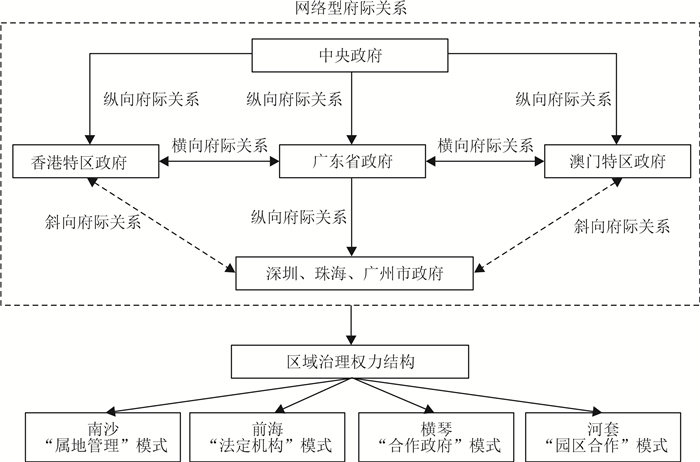
 下载:
下载:
